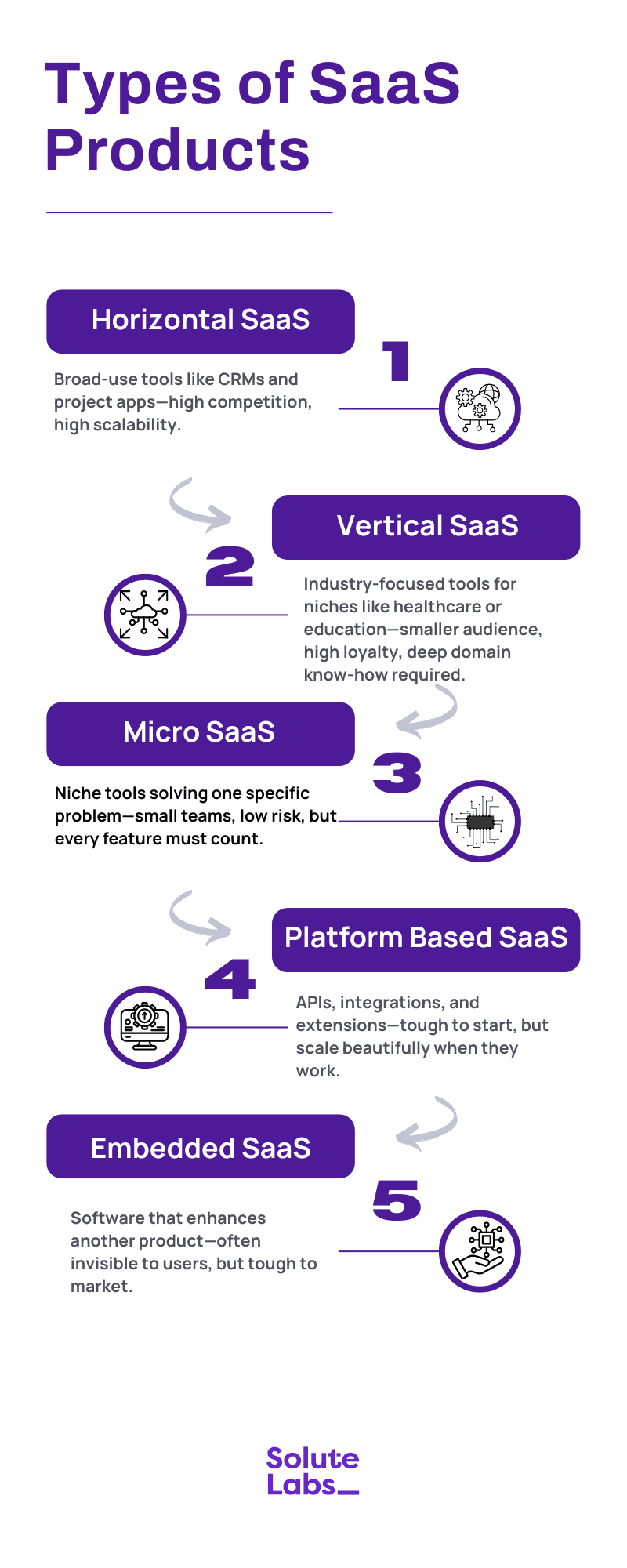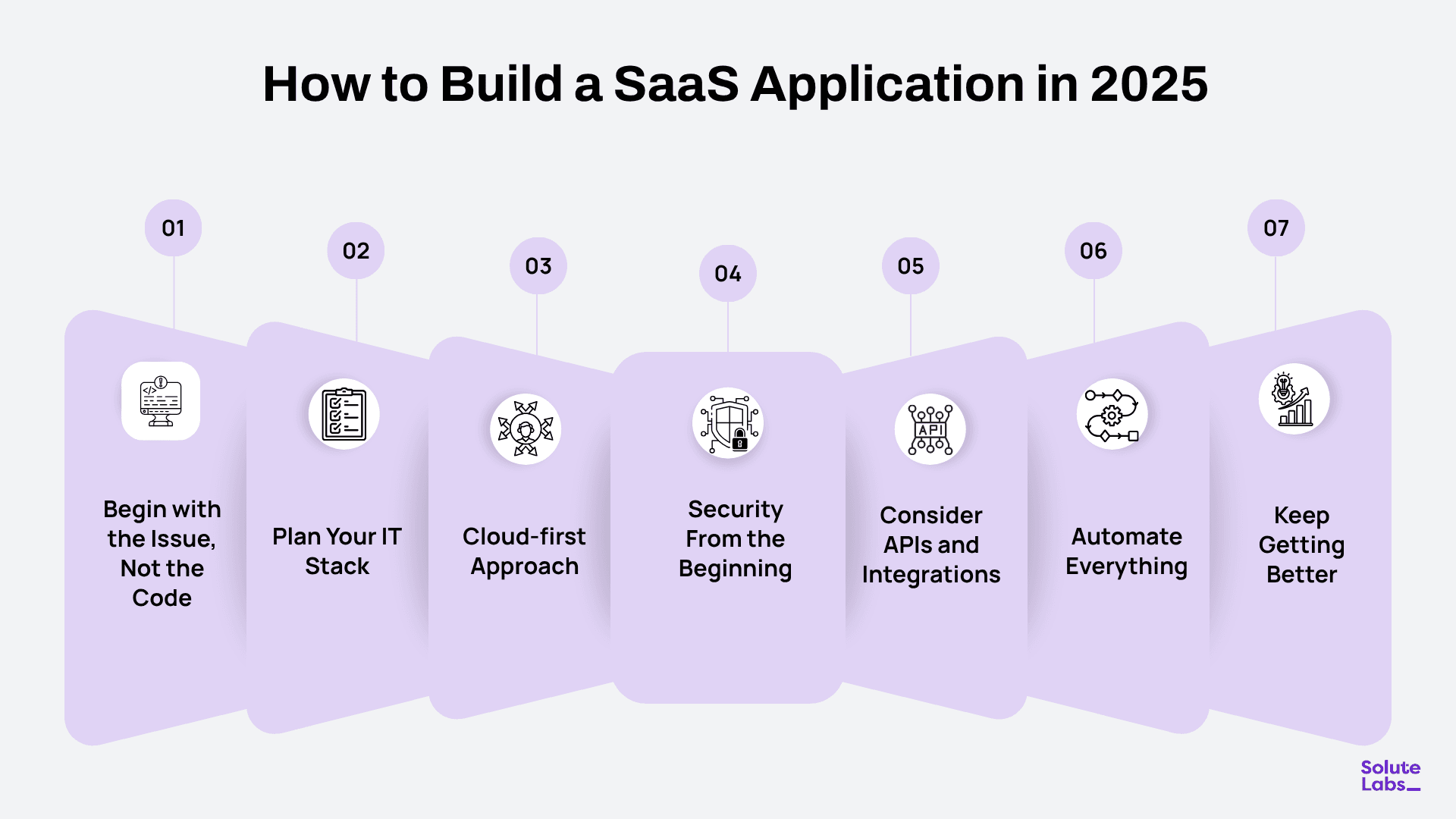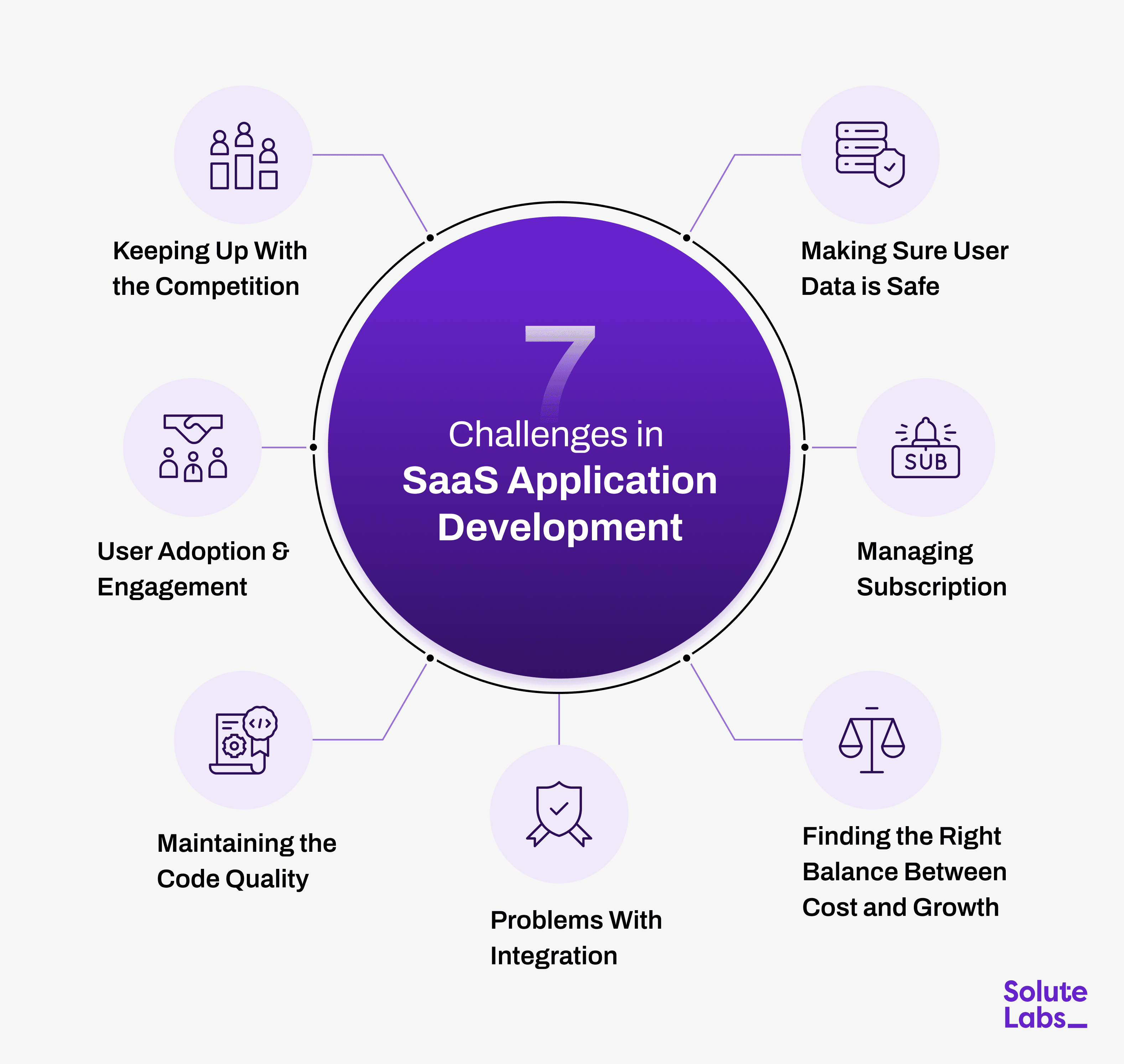Building software these days isn’t like it used to be. Gone are the days of floppy disks, endless downloads, or worrying if your software is compatible with your operating system. Now, almost everything lives in the cloud, and the SaaS model has become the new normal.
Here’s a crazy number to give some perspective: global spending on SaaS hits $300 billion by 2025. That’s massive, right? It basically tells us two things: people love subscription software, and businesses see the cloud as a goldmine.
So, if you’re sitting there wondering how to build a SaaS product, you’re in the right place. In this blog, we are going to walk you through it step by step, from the initial idea to launching your first version and thinking about growth.
What is a SaaS Product?
If you're sitting there and wondering how to make a SaaS product, you're in the right place. A SaaS product is basically software that is stored on the internet. You don't have to download it, install it, or worry about updating it yourself. You just have to log in for it to work. For example, Google Workspace, Canva, or Slack. You can get on from your home laptop, your phone on the train, or even a random computer at a cafe. The company that makes the software takes care of the boring things like updates, security, and servers.
In simple terms, what is a saas product? It’s software you pay to use, usually with a subscription, and it just… works. No headaches.
Some other things that make SaaS products stand out:
- You pay for access, not ownership.
- Updates are automatic.
- Cloud-based means you can scale as you grow.
- You can log in from anywhere.
- Multi-tenant architecture keeps data secure.
The best thing about SaaS is that it's a win-win: customers get convenience, companies get repeat business, and both sides can focus on what's really important: solving real problems.
Differences Between B2B vs B2C SaaS Product
Okay, let's talk about something that a lot of people forget: who your SaaS is really for. It may seem obvious, but if you don't do this, you'll fall into a trap. Are you going after businesses (B2B) or regular people (B2C)? Let’s find it out:
| Aspect | B2B SaaS | B2C SaaS |
|---|---|---|
Target Users | Teams, companies, and enterprise-level | Individual users or small groups |
Decision Timeline | Often weeks or months | Usually immediate, sometimes even impulsive |
Pricing | Tiered, per-seat, enterprise contracts | Freemium or low-cost subscriptions |
Features | Complex, includes integrations, analytics, and compliance | Simple, intuitive, easy to use |
Support | Dedicated account managers, SLAs | Community supports, chatbots, FAQs |
Onboarding | Demo calls, guided tutorials | Quick sign-up, instant access |
Marketing Focus | Productivity, Efficiency, and ROI | Convenience and ease of use |
Types of SaaS Products

Now that you know who you're making the product for, let's talk about what kind of SaaS product you want to make. There are different kinds of SaaS, and the kind you choose will affect how you design, build, and grow your app.
Here’s the rundown on the types of SaaS products used:
1. Horizontal SaaS
These are your “everywhere” tools. CRMs, project management apps, collaboration software, and stuff that almost any business can use. Broad audience, more competition, but easier to scale if you do it right.
2. Vertical SaaS
Industry-specific tools. Think software for hospitals, schools, and law firms. Narrow audience, but very loyal. The trick? You have to know the industry inside out. One wrong feature and they’ll ignore you.
3. Micro-SaaS
Tiny, niche solutions. Maybe you solve one very specific problem. Often run by a solo founder or a tiny team. Less risky financially, but every feature has to hit the mark. You can’t afford fluff.
4. Platform-based SaaS
These let other developers build on top. APIs, integrations, extensions. Harder to start, but if it works, it scales beautifully.
5. Embedded SaaS
This is software that doesn’t stand alone. It enhances another product. Users might not even realize they’re using a separate app. Cool, but tricky to market.
Also Read: SaaS Security: A Complete Guide on Issues & Best Practices
Benefits of SaaS Product Development
Developing a SaaS solution offers numerous advantages, some of which may seem nuanced until encountered firsthand. Here is the analysis:
- Predictable Income: Subscription models eliminate the need to pursue singular transactions. A consistent cash flow facilitates the planning of subsequent actions.
- Simplified Scalability: SaaS is cloud-based, enabling the addition of users or the enhancement of services without the need for software shipment or manual update installations.
- Minimal Entry Barriers for Users: Individuals can experiment with your program without incurring substantial initial costs. Complimentary trials or freemium models are highly effective.
- Automatic Updates: Upon deploying a fix or new feature, all users receive it immediately. Manual updates are unnecessary for anyone.
- Empirical Insights: You may observe precisely how users engage with your product. What features are prevalent? Which ones perplex them? These observations inform enhancements.
- User Convenience: SaaS solutions are accessible from any location and at any time, via computers, smartphones, and various devices. This flexibility enhances adoption.
To Build a SaaS Product From Scratch- Why is it Important for Your Business Growth?
Let’s break down why investing in saas product development actually drives growth:
- Recurring Revenue: Subscribers who pay for a service on a regular basis become long-term customers. You make money, people stay interested, and retention goes up.
- Grow Without Chaos: When you add people, you don't have to deal with a lot more servers or infrastructure problems. The work is done by cloud computing.
- Insights in Real Time: You learn from how things are actually used. Facts, not opinions, are used to make decisions.
- The Speed of Operations: You no longer have to worry about setting up software, maintaining servers, or installing changes all the time. Teams can work on making the offering better.
- Better Retention: Users always see value in updates, new features, and help, which keeps them subscribed for longer.
- Flexibility to Evolve: The cloud design allows for evolution, so you don't have to start from scratch when you want to change, improve, or add to your services.
How to Build a SaaS Application in 2025?

It's not the same to build a SaaS app today as it was a few years ago. Cloud technology, new frameworks, and current methods make things easier, but there are still a lot of moving components. Here's a useful way to look at it: •
- Begin with the Issue, Not the Code: Find out exactly what your users are having trouble with. Don't add features just because they sound cool.
- Plan Your IT Stack: Choose tools that make sense for your size for the frontend, backend, database, and hosting. You don't need the most advanced technology, only the correct one.
- Cloud-first Approach: AI-native Cloud and DevOps infrastructure is what makes modern SaaS work. It can be changed, grown, and will save you trouble later.
- Security From the Beginning: Think about compliance (yes, even early on), encrypt data, and manage permissions. If you don't, users will notice.
- Consider APIs and Integrations: Your SaaS will probably need to work well with other products. Make that simple.
- Automate Everything: CI/CD pipelines, auto-deploys, and automated testing all save time and cut down on mistakes.
- Keep Getting Better: Build, ship, gather feedback, and do it again. SaaS is a long race, not a short one.
Best Practices in SaaS Development
Building a SaaS product is hard, but if you follow a few good patterns, you may save a lot of problems later on. This is what really works in real life:
1. Start Small, Think Big
First, look at the most important features. Don't make your MVP too complicated; add further features afterward.
2. Make the User Experience Your First Priority
Make your app easy to use. People will depart if they are lost or confused in the first few minutes.
3. Keep the Interface Consistent
Consistency in both appearance and function makes users feel at ease and lessens their frustration.
4. Keep an Eye on Performance All the Time
People become angry quickly when apps are slow. Keep an eye on crashes, load times, and issues as they happen.
5. Make Plans for Growth Early
Even if you don't have many users right now, make sure your architecture can manage growth without having to be completely rebuilt.
6. Encourage Feedback Loops
Make it easy for users to provide you with feedback directly. They see things that you will never see.
7. Invest in Documentation and Support
A tiny amount of information or clear instructions can save customers a lot of time and trouble. These habits are about being smarter, not harder. If you do these things, your SaaS product will look and feel professional, even if it's still new.
Challenges in SaaS Application Development

Making a SaaS product seems fun, but there are a lot of problems that come up along the way. Most founders have to deal with these primary challenges in SaaS development:
- Making Sure User Data is Safe: Security is a must. Plan for encryption, backups, and access controls from the outset because one breach may ruin trust in a day.
- Managing Subscription: People unsubscribe more quickly than you anticipate. You need to have plans in place to keep them interested and coming back.
- Finding the Right Balance Between Cost and Growth: Cloud hosting is versatile, but if you don't pay attention to how you scale, costs can get out of hand.
- Problems With Integration: Your users may want your SaaS to work with other solutions. It may be really annoying when APIs don't work together.
- Maintaining the Code Quality: Technical debt can build up when you use quick fixes and shortcuts, making it harder and slower to make changes in the future.
- User Adoption and Engagement: Even the best features won't matter if people don't know how to utilize them. Onboarding, tutorials, and user experience are all very important.
- Keeping Up With the Competition: SaaS markets change quickly. You need to keep adding new features and staying relevant, but you don't want to stretch your crew too thin.
Cost of Building a SaaS Product
Understanding the expenses associated with SaaS product development is a fundamental step in strategizing your startup or expanding your current software enterprise. The expense of developing a SaaS application can fluctuate considerably based on factors including product intricacy, design specifications, technological framework, team proficiency, and infrastructural demands.
The development of a minimum viable product (MVP) for a SaaS platform typically costs between $40,000 and $150,000, whereas a comprehensive enterprise-grade solution may exceed $250,000. This variation arises from the quantity of features, integration with external services, data security protocols, and scalability factors.
Essential factors affecting the overall cost of SaaS product development comprise:
- Scope and Complexity: The scope and complexity of a basic SaaS dashboard contrast significantly with that of a feature-laden analytics or AI-driven platform.
- Design and User Experience: Intuitive UI/UX design frequently requires extra time and resources, yet it significantly influences user adoption.
- Team Structure: The structure of the development team, whether employing an in-house team, engaging freelancers, or collaborating with a specialized SaaS development firm, impacts total costs.
- Technology Choices: The selection of backend frameworks, cloud infrastructure, and database architecture can affect performance and expenses.
- Maintenance and Scaling: Post-launch expenses, including server hosting, updates, customer support, and feature enhancements, must be incorporated into your budget.
The SaaS product development cost extends beyond initial construction; it encompasses the creation of a sustainable, secure, and scalable product that provides enduring value. Meticulous planning and the appropriate development partner can facilitate cost optimization while guaranteeing superior results.
Conclusion
Building a SaaS product from scratch isn’t smooth or predictable. Some days everything clicks, and other days, nothing seems to move. You’ll tweak, rebuild, and question your choices more than once. But that’s part of the process; every challenge quietly teaches you something about what your product should really be.
What matters most is staying patient. Keep your eyes on the people who’ll use your product and keep adjusting. Growth won’t come in a straight line; it’ll come in waves. The trick is to ride them, learn fast, and not lose heart when things slow down.
And if you’re at that point where your idea feels real but you’re unsure how to build it, SoluteLabs can step in. We’ve helped many founders shape their vision into something solid, SaaS platforms that don’t just work but genuinely make life easier. Maybe yours is next. So, what are you waiting for? Contact us now







